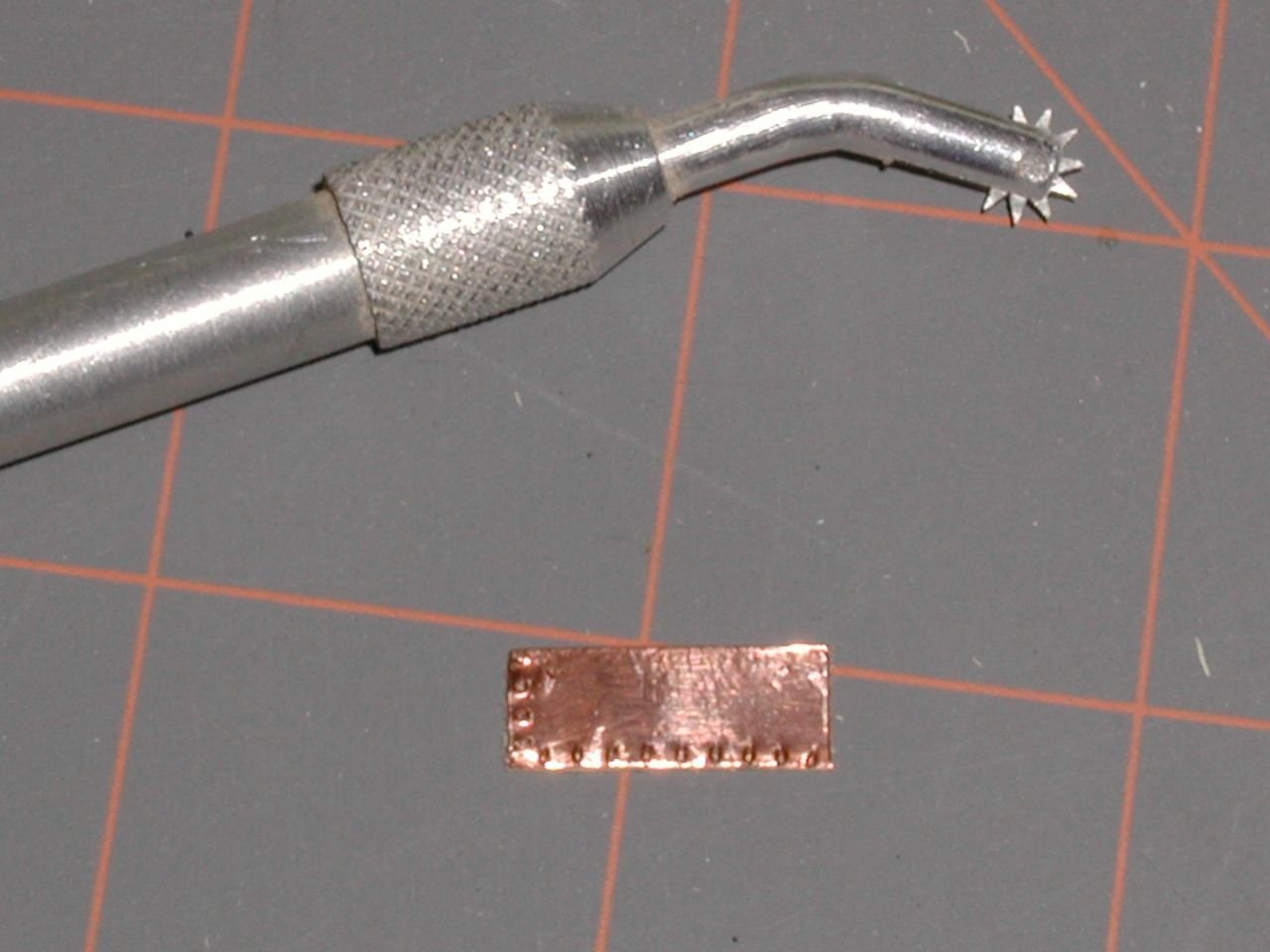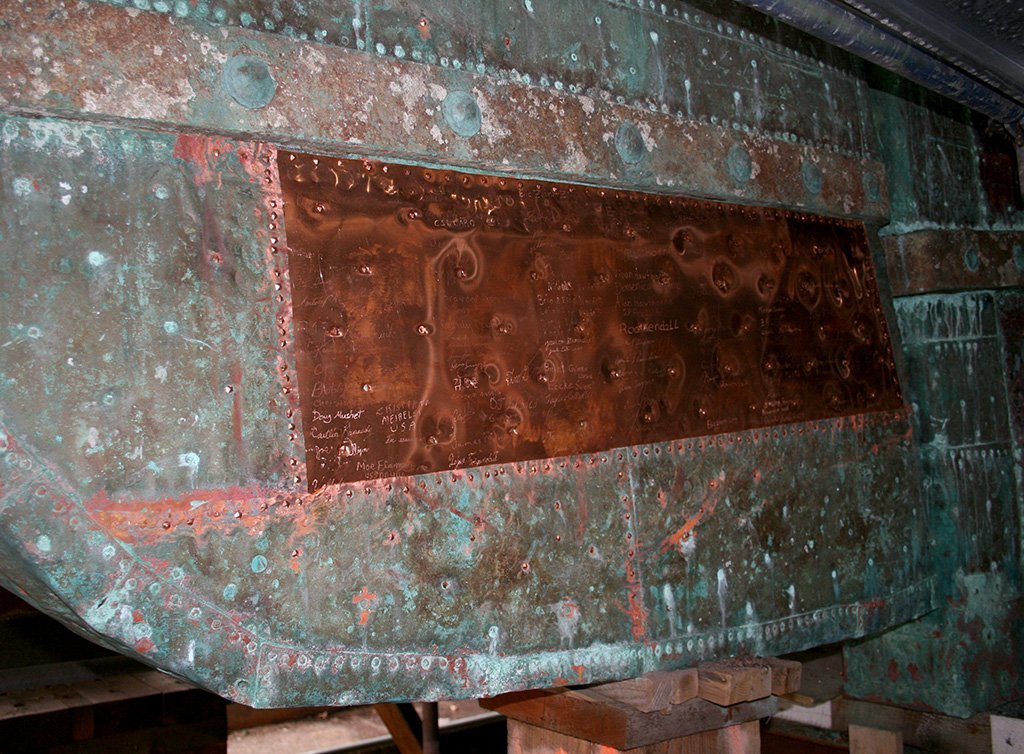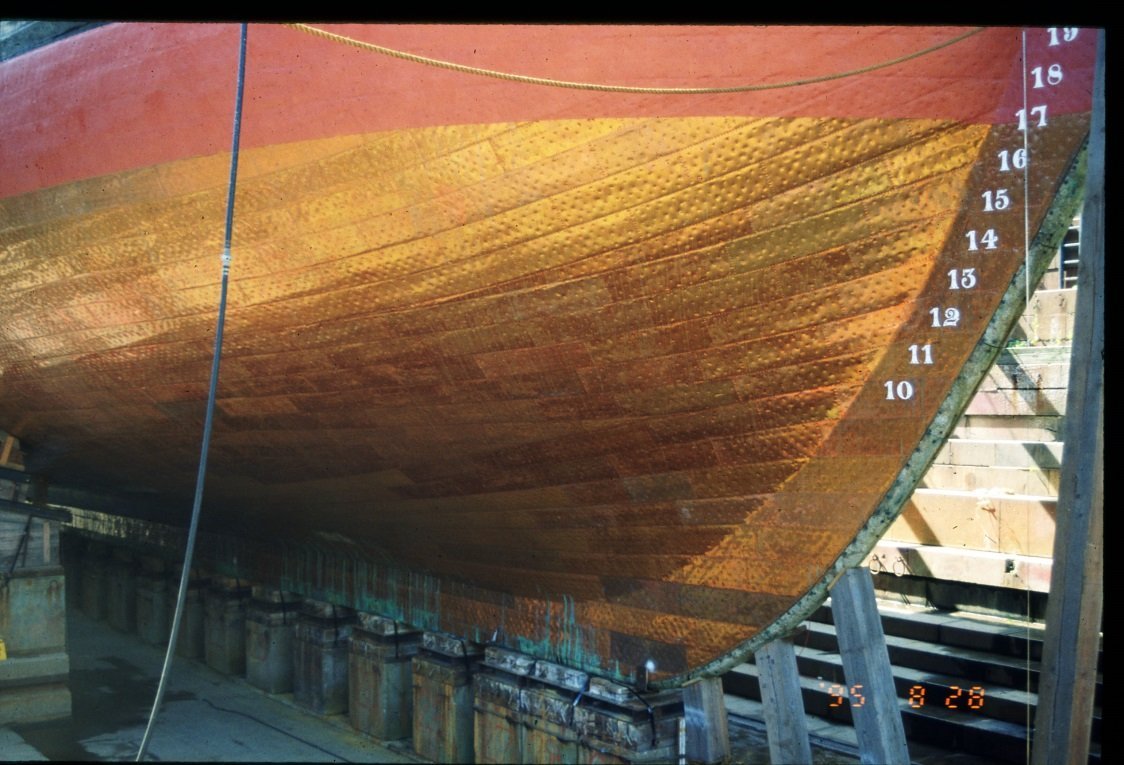-
Posts
2,641 -
Joined
-
Last visited
Content Type
Profiles
Forums
Gallery
Events
Posts posted by JSGerson
-
-
-
If you go to the USS Constitution Museum site, you will find a lot of US Plans of the ship. I found one that may help you with the bow bumkins.
Jon
25175 - Deck Framing Forward of Stern and Fore Tack Bumpkin.pdf
-
I decided to take the "easy" route and make my model based on the 2015-17 restoration. I say "easy" because of all the photographs that have been taken and accessible through the internet. Most builders who choose to create a historical version have to rely on contemporary paintings and models (e.g., 1812 Issacs Hull Model). Most often they choose the 1812 version. I need to see what I am modeling, so I'm making the contemporary version. The Model Shipways kit is based on the 1927-31 restoration. So, the obvious thing I had to do was remove the Top Gallant rail and add the waist. The 2015-17 restoration also removed the bow rail. Of course I won't be adding any tourist enhancements (gun port nets, speakers, etc.).
BTW, silver soldering is done with a small torch as opposed to an iron. You can see how it's done on You Tube. Usually the videos are posted by jewelry makers, but the process is the same. My Conny is the first time I ever did silver soldering.
Jon
-
I've got a long way to go before I get to the stanchions (cages) so my thoughts are conjecture . All of the methods I've seen used silver solder (which I plan on using), which isn't too difficult...relatively. The solder sets quickly, and can be removed to start over if needed. However, the only other method I can think of is epoxy. Like solder, it will require removing excess joint material, shaping the joints, and in the case of epoxy, painting the epoxy joints to match the brass work. I don't think this method is any easier; more likely be harder. Don't know if this helps, but it's all I got.
Jon
-
My philosophy on details and accuracy is simple. I like detail where the closer you look; the more detail is revealed. What most of us are making are models, not accurate miniature reproductions. Things like tree nails that I added on my Rattlesnake hull and deck, I did not accentuate their presence by increasing their contrast so you could see them better. From a foot away, the casual observer would not see them. Get closer, the detail reveals itself. On the real ship they blend in with the background wood. I got the detail and some of the accuracy.
On my Constitution there is no point for tree nails, the scale is too small and everything is painted. I am copper plating the Constitution’s hull with individual copper plates, but I total ignored the copper plate nail pattern found on the actual ship. The detail is too small for the scale, but I tried to give the impression of nails in the plate. I embossed the plates with rough sandpaper, so the plates are not shiny mirror smooth and give the impression it is covered with copper nails. Sometimes I do add detail that the typical viewer would not see (“for God’s eye”) because it was just fun to do, I try to balance the effort of creating that detail versus the chances of actually seeing it on the model. If it’s “easy and fun” to do I might add it. If it is difficult, probably not. I provided enough detail (hopefully) but not all on the gun deck furniture so that when viewed through the (planed) selected opened planks of the spar deck, the observer will get a sense of what it looks like below decks. The builder is the master of his model world. If it pleases him (her), then it’s good enough.
-
Brian, I have personally collected over the past 10 years approximately 19,000 images (organized in my particular manner) of the USS Constitution, from a variety of sources, covering most of her photographic history. I'm still building my model, so I am still collecting. Should you or anyone else need images of a particular view, angle, item, etc. of the USS Constitution, there is a good chance I may have something to help you.
- mort stoll and Brian Falke
-
 2
2
-
Very nicely done! I suspect of all of the attributes you listed, ...
QuoteWith the lamp, perseverance, focus and some salty seaman’s language, I got the other four rigged in less time than it took to rig the first one.
..."salty seaman's language" was probably the easiest to learn 😁
-
Progress report on the copper plating: I believe I am approaching the halfway point, if not already on it. If you look closely, you may notice two areas of the keel where the sides are not covered in copper. I left those aeras untouched so it can be identified as the places I used wood from the actual ship. Also, I have not yet plated the bottom of the keel.
- KurtH, GrandpaPhil and robdurant
-
 3
3
-
-
Avi, I already tried that. See May 23, Post #159
-
Quote
I’d be happy to. I don’t think this build log is the right place for it. Is there a better thread, or some good place to upload them?
I queried Model Ship World to see if there was some sort of a Photo Reference Library and if not, why not. They said there wasn't:
Quote"The most likely reasons are
- no one has asked for one (or at least very few people have asked), and
- it would probably entail a not insignificant amount of work for an MSW staff member.
On top of those two reasons, sharing photos gleaned from the internet often constitutes some form of IP infringement.
So the best place to post any of your images is your own build log. I hope you do."
Jon
-
Has anyone started a photo library of reference material for specific ships, say USS Constitution for example. I've got thousands of images I use as reference material for the Constitution that I gathered from the internet as well as pictures I shot. Some of us would like to share photos we've gathered and pool them into categorized and organized library of sorts but outside of a specific builder's build log. If so, where is it. If not, why not?
-
Avi, up until the late 70s, I lived in the suburbs of Boston and enjoyed a lot of the amenities of the city, among them visiting the USS Constitution. I got one last in person look at her just before her last restoration. I have amassed a large library of images of the ship which I'm willing to and have shared with others for the asking, but I am always looking for new images, different angles, those little gems of details that help me with my model. Unfortunately, I don't have a lot of images of her since the 2015-17 restoration. Would you be willing to post your pictures so the rest of us can enjoy them too?
Jon
- mort stoll and Bill Morrison
-
 2
2
-
- KurtH, Prowler901, GrandpaPhil and 1 other
-
 4
4
-
A week or so into copper plating and all is going slow (my usual pace) with decent results. I did run into one annoying problem – the plating wants to lift up even after multiple burnishing. I burnish by rolling a short 3/8” diameter wooden dowel over the copper tape. I want to flatten the embossing, not rub it out. With carefully applied CA glue under the plates that lift, I gotten most of them to stay down. So it’s two steps forward and one back. The pictures below show only one side although both sides are being plated at the same rate.
-
Your Conny is looking good.
Sounds like your surgery was successful. I know exactly what you are going through with your back. I had back surgery in 2019. Eight hours on the table, and numerous screws and pins later, I feel better. I have some loss of flexibility due to the lower back vertebrates being fused, but for the most part, I'm pain free. This was my second surgery, the first one was 40 years earlier. If this one is half as good as the first, I'll be very happy. I hope yours lasts a long time too.
-
-
I hope you got my PM with the file you requested. I have another file for the shield on the trailboard. It will be a while before I get to that point as I've started to copper plate the hull first. BTW, those are not gun ports opening on either side of the rudder. They lead into the berth deck steering mechanism space, although I haven't been able to identify the opening from any inside photos I've found. My guess the openings are used for ventilation and for emergency steering ropes that could be attach to the rudder if need be.
-
-
I remember this method now! It's a very ingenious and it makes for a fast process. Although your log was short, I was impressed when followed your build. I'm kind of machoistic in doing some things the hard way. My method is time consuming, detailed, and prone to missteps, but I think I'll like the results a bit better. Thank for reminding me. I have some ideas that your method has inspired to streamline my process.
-
I have several choices for my copper plates:
- Full accuracy - Make an embossing stamp for ½” x 3/16” plates. Problems, the copper tape is ¼” wide, I need to make the stamp and jig to create 50 interior dimples plus a method to make the close quarter edge dimples
- Impressionable – give the impression of nail indentations only
- No nail impressions at all and may or may not overlap the plates
I made the pattern for the fully accurate pate by counting the nail heads and their locations on the real plates from photographs. When I reduced the pattern down to scale size, the nail pattern would be indiscernible let alone easy to make. When I considered the number of plates needed, I didn’t think it was worth the effort.
What I call the impressionable method is relatively easy to do, but still tedious. The idea is to emboss the copper using sandpaper. The rough surface of the sandpaper would make random impressions in the copper just enough for the viewer to realize the copper has some texture detail, not enough to discern a pattern while cutting down the mirror finish of the copper tape. I do have a method for the edge nails using a method which I’ll discuss below
The last method is just to add plain copper plates straight off the copper tape roll without any embellishments, just cut to size. The relies on the idea that the scale is so small, you can’t see the details.
I felt that the impressionable method might be the best way to, but I had to make a test run first. I cut a few ½” length strips for my trial and create the plate with these steps:
- Cover the plate with a piece of coarse sandpaper and using another block of wood (not shown), lightly tapped the block so it forces the sandpaper into the copper.
- Per Nautical Research Guild’s Ship Modeler’s Shop Notes II, Pgs.138-9 I used a fine-tooth modeler’s saw blade and with a single tap embossed the edge of the plate top and one side.
- Just rubbing the plate with my fingers to burnish the plate smooth.
From just a few inches away, any discernable pattern would have been lost in the full accuracy method, so this method is my choice.
-
The practicum uses a coppering method which I feel could use a little improvement. Mr. Hunt used a ponce wheel to make plate edge dimples on the copper plate edge. Unfortunately, I feel they are oversized for the scale and look more like a boilerplate. A lot of builders used this method of just outlining the plate, and some made them with bumps raising above the plate like rivets. But after seeing actual pictures of the Constitution’s plating, I going to attempt an alternative method of embossed plates.
According to Roger Frye’s Shop Notes in the Nautical Research Journal V66-4 Winter 2021:
Quote“Many attempts that emboss the plates result in bumps or dimples that are over size and draw too much attention to this feature. In full size practice, nails are pounded flat leaving only a small depression. Since the nailing pattern is generally subtle the decision on whether or not to depict it becomes a matter of scale. There seems to be a consensus that depicting nailing in 1:96 scale or smaller is difficult to appreciate without magnification and can be eliminated, while at 1:48. scale or larger the nailing pattern adds visual interest if done realistically.”
Per the quote above, the range between 1:96 scale and the Model Shipways kit at 1:76.8 scale, is left to the judgement and skills of the builder. The plate nails make small minor depressions so the indentations will have to be almost flat, just enough to disrupt the natural smooth mirror finish of the copper tape that is provided in the kit. The first image below is what Mr. Hunt created. The following images are of the actual ship for comparison.
- Scallywag, Bill Morrison, Nirvana and 1 other
-
 4
4
-
Coppering Preparation
Once more I’m deviating from the build sequence laid out in the practicum. Instead of moving on to the stem with all its complications intricacies, I’ve elected to work on coppering the hull before any delicate structures are added to the stem. Thus, I painted more of the hull black to just below the waterline. The copper plates will eventually define the actual waterline once they are installed.
- Tomculb, GrandpaPhil, Bill Morrison and 2 others
-
 5
5
-
The openings in the hull required a bit more manipulation with drills and files because the final opening shape was oblong. Also, during the installation, I had to make sure that the scupper lid swung open forward on both sides of the ship due the requirement that the lid hinge (which is covered by the open lid) is always on the forward side of the scupper. I’ve not found another builder who has done this.
- KurtH, CiscoH and Stevenleehills
-
 3
3







USS CONSTITUTION by Brian Falke - BlueJacket Shipcrafters - Scale 1:96
in - Kit build logs for subjects built from 1751 - 1800
Posted
I have no idea if your measurements are correct but hopefully these plans from the US Navy (which are available at the USS Constitution Museum website) will help.
Jon